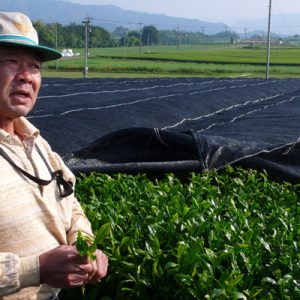Green Tea: Tasting and Health Notes

Contrary to popular practice, the full profile of a green tea is not obtainable by infusing the tea in a glass.
Green teas are very different from black teas in material nature and one key difference in tasting is the required infusion temperature. For most green teas, temperature over 90°C almost definitely kill whatever good taste your tea may have. With a few exceptions, 85°C or below fares well. Some thoroughly twisted ones, such as Gyokuro, requires water temperature to as low as 50°C, but at least 100% more leaves and less than a third the standard infusion time. Click here to find out>
tasting notes
Every person has his own concept as to how a green tea should taste. Some like it light and easy, so they steep it for a couple of minutes. Some like it strong so they may want to steep it for a full 5 or 6 minutes. A mug with an infuser, a teapot, a gaiwan or any jar with a cover can be a good tool. Some people prefer to use a tall glass without cover — it’s good to look at, but not giving you the best of your tea. If you do not decant all the liquid from whatever you are using for the steeping, be prepared the last few sips can be very bitter.
A good high grown green tea can deliver a full body in a dense, almost syrupy liquor to illustrate the ideal of “liquid jade”. A really fine one can taste quite round, long and deep and is balanced with just enough, but not over, bitterness and astringency. Proofing the quality through a strong infusion, therefore, is a good way to experience how good your tea really is. It is also a good drink once now and then, just for the punch of it.

Boris Kustodiev: The Merchant’s Wife, 1918. Sipping freshly brewed tea from a tea dish seems still fashionable in early 20th century Russia. Slim figures seem not.
To prepare a good strong cup, use 50% to 100% more leaves than standard in a good high density Yixing pot and infuse for 4 to 6 minutes, depending on the variety and selection. Lengthening the time would not do any good to the taste. Drink while it’s still hot. Remember: colour is not an indication of strength.
health notes
Green tea is the category with the richest content of flavonoids and theanine. EGCG ( Epigallocatechin 3-gallate ), a tea polyphenol and the most powerful of the catechins in anti-mutagenic and anti-oxidative effects, is by far the highest in green tea. That maybe why this is the most popular choice for those who drink tea more for its health contributive nature. However, some people tend to forget that tea is not a health supplement pill. Tea is a natural beverage (and food) that comes in a total package. Each selection has its own character and contains a large number of active substances which synergic effects have yet to be understood scientifically.
While there is no doubt that green tea is the drink with the most salutary nature, some people can feel sick drinking a few cups of it daily. This is because in TCM term, green tea is cold/cool in nature. Some people’s health conditions are just not up to it.
different people, different teas
In particular, people with a TCM “cold” body foundation should drink green tea with constrain or as recommended in the drinking style below, or switch to a tea category recommended below. A cold foundation is manifested in these conditions: lower than normal body temperature, cold hands and feet, paleness, easy fatigue, easy diarrhea, frequent and pale urination, and over sensitivity to wind and change of temperature; some may even have poor digestion or slight anaemia.
Some green tea varieties are a lot “colder” than others:
- Sun-dried green tea is the coldest in nature. That is why “Sheng” type Puer should be used with constrain, until it is very fully matured.
- Steamed green tea comes in next. Varieties such as gyokuro and sencha are to be avoided during and after meal in particular, so as not to reduce digestion functions. Women during menstruation and pregnancy should also use these first two types with constrain.
- Baked and low fire roasted green teas are the third, use with moderation.
- Thoroughly roasted ones are the least cooling in nature and can be used with more flexibility.
The body takes in a green tea most easily in the afternoon, when the body heat is the highest in the day, and thus most acceptable to a cooling nature tea.

Nausea after green tea? Green tea may not be the tea everyone.
How the tea is drunk changes its properties. When tea is drunk hot, the temperature stimulates the inner linings of the digestion tract and so absorption of the tea materials is more balanced. When a cup of green tea turns cold and is drunk, the “cold” nature of tea surfaces to attract phlegm (note) (in TCM term, this word generally refers to “damp toxins” of the body).
One way to prevent this is to always prepare just enough tea for immediate consumption, rather than letting the big cup to become cold when it is only half way through. That is exactly why the gongfu infusion style a much healthier way of enjoying tea.
maybe another tea category
Another way is to choose a tea category which nature is modified when it is produced, such as white teas and oolongs. Both have the benefits of green tea, and their own unique salutary contents. However, if you want white tea to avoid the concerns of green teas, choose a well oxidized one, such as a Zhenghe White Peony. Very lightly oxidized ones, such as Silver Needles and very green varieties of White Peony are very close to sun-dried green tea in TCM nature.
On the other hand, people who are hyper-active, easily over-excited, hot-tempered, sensitive to heat, and who have constipation, and short, yellow urination, and whose mouths and tongues feel hot and dry frequently — i.e. those who have a “hot” body foundation, would benefit very well from the cold nature (TCM term) of green tea. It is still advisable not to drink these teas cold for anybody.











1 Response
[…] of it. They have proven to be a key contributor to the positive results of all these studies. And green tea has a lot of them. While a tablet of tea extracts may give you 250, 500, or 1000 mg of them, you […]